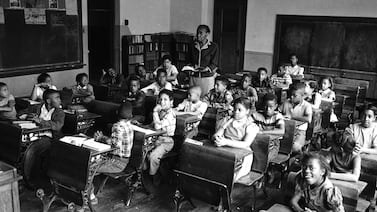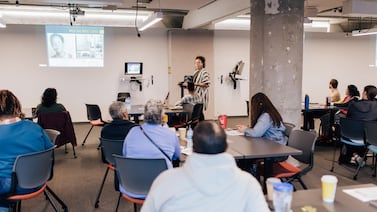Sign up for Chalkbeat’s free weekly newsletter to keep up with how education is changing across the U.S.
Over the last three decades, school segregation has been increasing — and it has increased the most within the large school districts that enroll many of the nation’s students of color.
Schools have become more segregated in these communities even as neighborhoods have become more racially mixed and as economic inequality between racial groups has declined.
Two main factors are driving the increase: the end of most court oversight that required school districts to create integrated schools, and policies that favor school choice and parental preference.
Those are the findings of new research on school segregation from Sean Reardon of Stanford University and Ann Owens of the University of Southern California. Their analysis coincides with the 70th anniversary this month of the U.S. Supreme Court’s landmark decision in Brown v. Board of Education, which ended legally mandated racial segregation in public schools and overturned the doctrine of “separate but equal.” They said the findings should “sound an alarm for educators and policymakers.”
“Although school segregation is much lower than 60 years ago, both racial and economic segregation are increasing,” the authors wrote. “Those increases appear to be the direct result of educational policy and legal decisions. They are not the inevitable result of demographic changes — and can be changed by alternative policy choices.”
The analysis includes an interactive map that allows users to see school integration and segregation trends in their communities.
Reardon and Owens looked at national school enrollment data, including going back to 1967 for communities where older data was available. School segregation fell sharply after the Supreme Court’s Green v. New Kent County decision in 1968. The decision banned “freedom of choice” plans that states had used to undermine integration efforts and mandated desegregation plans in many districts.
The study measures segregation using a normalized exposure index, which compares the demographic makeup of schools attended by students of a particular racial group. The number 1 represents complete segregation and 0 represents fully integrated schools.
Overall, schools remain far more integrated today than they were before 1973, the analysis found. The 1970s saw widespread busing programs to create racially balanced schools, programs that continued into the 1990s in some communities.
Between 1991 and 2019, Black-white segregation increased by 3.5 percentage points in the 533 districts that serve at least 2,500 Black students, an increase of 25% from historically low levels. But in the 100 largest school districts, which serve about 38% of all Black students, the analysis found segregation increased by 8 percentage points — a 64% increase.
Hispanic and Asian American students attend more integrated schools on average than Black students, but rates of white-Hispanic and white-Asian American segregation have nearly doubled since the 1980s, the analysis found.
In Denver, advocates found that Latino students and English learners are especially likely to attend very segregated schools. A study last year that looked at wealthy California school districts found that white families move away as more Asian American families move in — and fear of academic competition may be a factor.
Economic segregation increased considerably in that same time period, Reardon and Owens found. In 2019, the average Black student attended a school where the rate of students receiving free- or reduced-price lunch was 18 percentage points higher than in schools attended by white students in the same district.
Segregated schools affect student opportunities
The high rates of poverty in predominantly Black and Hispanic schools contribute to the test score gaps and opportunity gaps associated with segregation, Owens said.
“It’s not that sitting next to a student of a certain race makes the school good or bad,” she said. “But we’ve never done ‘separate but equal.’ Until we eliminate broader systemic underlying inequalities in our society, we haven’t shown an ability to actually serve kids equitably.”
Owens said previous research on contemporary school segregation has focused more on metropolitan areas, finding more segregation between school districts than within them. That continues to be the case. But those analyses obscured how much segregation was increasing in large school districts where most Black and brown students attend school, she said.
Smaller school districts tend to have fewer schools overall and serve relatively fewer students of color. The result is that those schools are more racially integrated.
In larger school districts, neighborhood segregation contributes to school segregation — but it hasn’t driven the increases in school segregation over the last few decades, Reardon and Owens said, because neighborhood segregation has been declining during the same time period.
Perhaps unsurprisingly, their analysis found that the end of widespread court-ordered integration efforts, along with other voluntary school integration policies, has played a major role in schools becoming less integrated. School re-segregation accelerated starting in 2000, after court oversight ended in the 1990s. They estimate that school segregation would be less by about 20% if court orders had remained in place.
The researchers also found that charter school expansion was strongly associated with less integrated schools. The study did not look at the impact of private school choice programs, such as school vouchers, or district open enrollment policies. Instead, the authors treated charter expansion as a proxy for a robust school choice system, as those policies often go hand in hand.
Studies have found that school choice policies can accelerate gentrification, allowing affluent families to buy homes in low-income communities while opting out of the local schools — one reason racially integrated neighborhoods don’t always lead to racially integrated schools.
Reardon said they didn’t look at whether charter schools themselves are more segregated than district-run schools. That type of analysis can be misleading if, for example, a school district closed schools that mostly served Black and Hispanic children and replaced them with charters. Instead, they looked at the growth of charter schools over time within a school district and whether the district as a whole became more segregated. They found a strong association between the two.
The analysis estimates that school segregation would be less by about 14% without charter expansion.
Previous research by Brian Kisida of the University of Missouri and Tomas Monarrez and Matt Chingos of the Urban Institute also found that charter schools contribute to segregation. However, the effect was more modest, accounting for about 5% to 7% of school segregation. Students crossing district lines to attend charter schools offset some of the segregating effects.
In a separate paper, the same authors found that in neighborhoods with more Black and Hispanic representation, charter, private, and district schools contribute equally to school segregation, while in neighborhoods with less Black and Hispanic representation, private schools contribute the most to school segregation, though charters also play a role.
Brian Gill, a policy fellow at Mathematica who has studied charter schools, said people should not make a leap between charter schools contributing to less integrated schools and charter schools contributing to achievement gaps between students of color and their white peers. Many parents of color choose charter schools because they believe they will better serve their children. The better outcomes urban charter schools produce for Black, Hispanic, and low-income students should be considered alongside the potential harms of less integrated schools, he said.
“Whatever we have now is nothing like the legally imposed separation that existed before Brown,” he said.
Reardon said he’s not arguing that charter schools are bad or that parents having choices is bad.
“We’re saying that one consequence, empirically, of the expansion of this kind of choice regime is that it leads to more segregation,” he said. “And that should be taken into account in policy thinking about how we design school systems.”
Erica Meltzer is Chalkbeat’s national editor based in Colorado. Contact Erica at emeltzer@chalkbeat.org.









